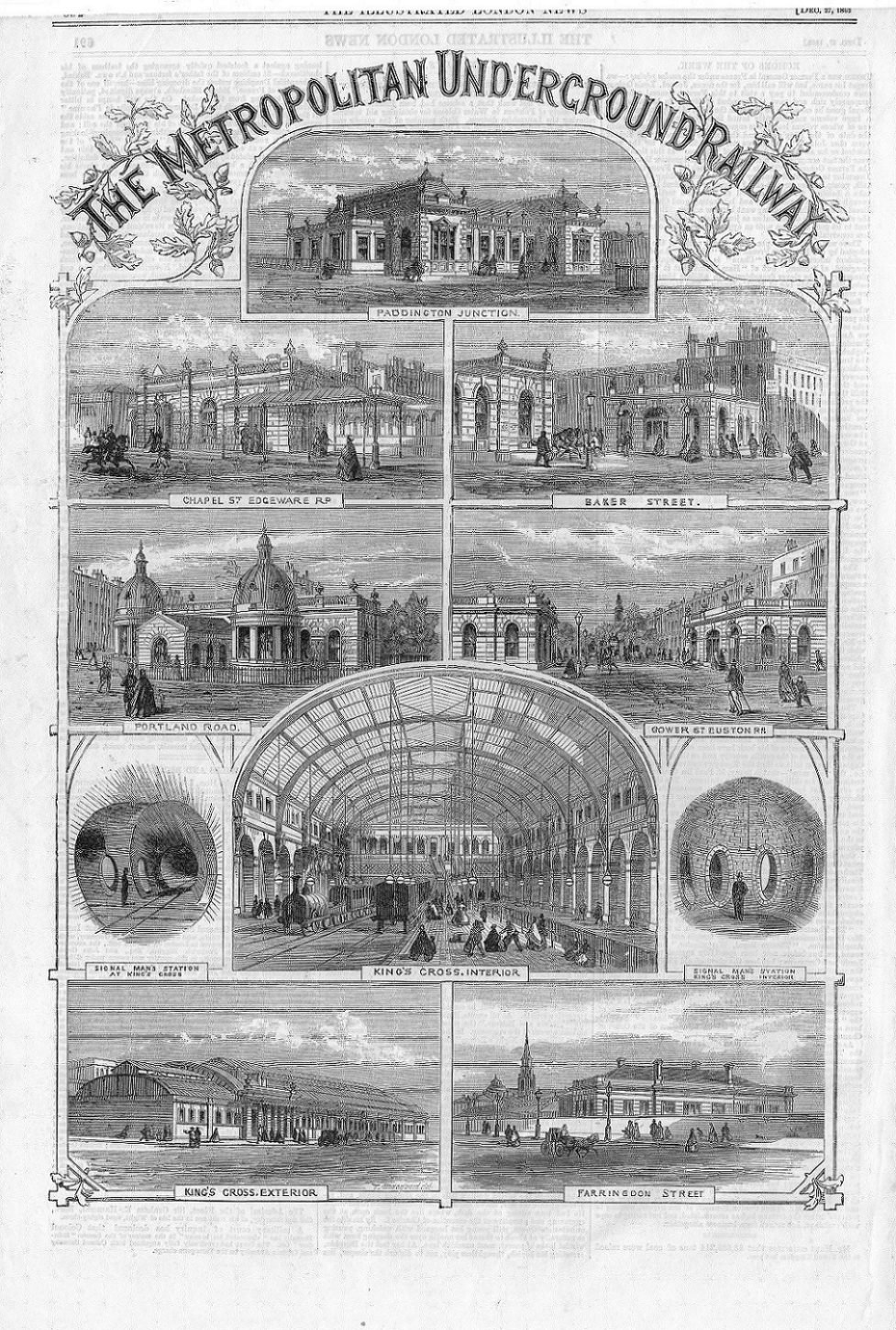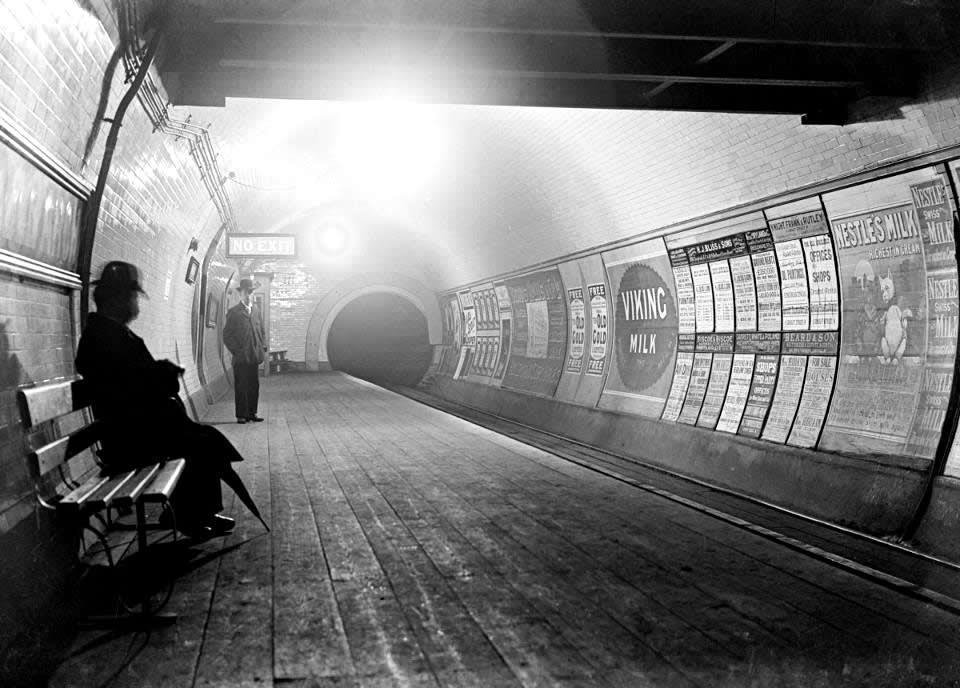The London Underground: Difference between revisions
(→1863) |
(→1900) |
||
| Line 49: | Line 49: | ||
=== 1900 === | === 1900 === | ||
[[]] | [[File:London Underground circa 1900.jpg]] | ||
<br> | <br> | ||
<br> | <br> | ||
Revision as of 16:54, 12 December 2020
[[]]
Paddington is served by four London Underground lines through two separate stations: the Bakerloo, Circle and District lines have a combined sub-surface and deep-level station to the south of the main-line station, and the Hammersmith & City and Circle lines have a sub-surface station to the north. Circle line services go through both of the sub-surface stations as part of a spiral route. Although shown on the London Underground map as a single station, the two sub-surface parts are not directly linked.
Although Paddington is not served by the Central line, the short walk to Lancaster Gate tube station is taken by many commuters heading for the West End or the City, as it can be quicker than alternative routes. History Circle and District line platforms
The first underground railway station was opened as Paddington (Bishop's Road) by the Metropolitan Railway (MR) on 10 January 1863 as the terminus of the line from Farringdon. The station was to the north of the main-line station and, from 13 June 1864, MR services were extended westward via a connection to the GWR's Hammersmith branch, now the Hammersmith & City line.
On 1 October 1868, the MR opened a branch to Gloucester Road, with a station called Paddington (Praed Street) in a cut-and-cover tunnel parallel to that street south of the main-line station. The deep-level Baker Street and Waterloo Railway (now the Bakerloo line) station opened on 1 December 1913 as a temporary terminus of an extension from Edgware Road to Queen's Park.
Services on what became the Circle line in 1949 were originally shared by the MR and the District Railway. Hammersmith & City line services were originally operated as part of the MR (later the Metropolitan line) and were separately identified as the Hammersmith & City line in 1990.
From December 2009, the Circle line was altered so that trains run in a spiral from Hammersmith via Ladbroke Grove to the Bishops Road platforms at Paddington, then on to Edgware Road, Kings Cross, Tower Hill, Victoria, High Street Kensington and back to Edgware Road via the Praed Street platforms at Paddington. This means that eastbound trains from the District and Circle line platforms all terminate at Edgware Road, the next station. Passengers for stations beyond Edgware Road either have to change there, or use services from the Hammersmith & City line platforms. All trains towards King's Cross now leave from the same platform, instead of being split between two platforms some distance apart.
The platforms of the Hammersmith & City and Circle lines (Bishop's Road) station are still separate from the other Underground platforms; they are numbered (15 and 16) in the same sequence as the main-line platforms. Interchange between the Bakerloo, District and Circle line platforms and the Hammersmith & City and Circle line platforms involves walking the length of the main-line station outside the Underground barrier lines, although the ticket barriers are programmed to permit changing between the two stations as part of a single journey.
- -- Charing Cross Station
- -- Elephant and Castle Station
- -- Paddington Station
- -- Tottenham Court Road Station
History of the London Underground
The history of the London Underground began in the 19th century with the construction of the Metropolitan Railway, the world's first underground railway. The Metropolitan Railway, which opened in 1863 using gas-lit wooden carriages hauled by steam locomotives, worked with the District Railway to complete London's Circle line in 1884. Both railways expanded, the Metropolitan eventually extending as far as Verney Junction in Buckinghamshire, more than 50 miles (80 km) from Baker Street and the center of London. The first deep-level tube line, the City and South London Railway, opened in 1890 with electric trains. This was followed by the Waterloo & City Railway in 1898, the Central London Railway in 1900, and the Great Northern and City Railway in 1904. The Underground Electric Railways Company of London (UERL) was established in 1902 to fund the electrification of the District Railway and to complete and operate three tube lines, the Baker Street and Waterloo Railway, the Charing Cross, Euston and Hampstead Railway and the Great Northern, Piccadilly and Brompton Railway, which opened in 1906–07. By 1907 the District and Metropolitan Railways had electrified the underground sections of their lines.
Under a joint marketing agreement between most of the companies in the early years of the 20th century, UNDERGROUND signs appeared outside stations in central London. World War I delayed extensions of the Bakerloo and Central London Railways, and people used the tube stations as shelters during air raids in 1915. After the war, government-backed financial guarantees were used to expand the network, and the tunnels of the City and South London and Charing Cross, Euston and Hampstead Railways were linked at Euston and Kennington, although the combined service was not named the Northern line until later. The Piccadilly line was extended north to Cockfosters and took over District line branches to Harrow (later Uxbridge) and Hounslow. In 1933, the underground railways and all London area tram and bus operators were merged into the London Passenger Transport Board (LPTB). The outlying branches of the Metropolitan were closed; various upgrades were planned. The Bakerloo line's extension to take over the Metropolitan's Stanmore branch, and extensions of the Central and Northern lines, formed part of the 1930s New Works Programme. The outbreak of World War II in 1939 halted or interrupted some of this work, and many tube stations were used as air-raid shelters.
The LPTB was nationalized in 1948, and the reconstruction of the mainline railways was given priority over the maintenance of the Underground. In 1953 an unpainted aluminum train entered service on the District line, and this became the standard for new trains. In the early 1960s the Metropolitan line was electrified as far as Amersham, and steam locomotives no longer hauled passenger trains. The Victoria line, a new tube line across central London, opened in 1968–71 with trains driven automatically. In 1976 the isolated Northern City Line was taken over by British Rail and linked up with the mainline railway at Finsbury Park. In 1979 another new route, the Jubilee line, took over part of the Bakerloo line; it was extended through the Docklands to Stratford in 1999.
Under the control of the Greater London Council, London Transport introduced in 1981 a system of fare zones for buses and underground trains that cut the average fare. Fares increased following a legal challenge but the fare zones were retained, and in the mid-1980s the Travelcard and the Capitalcard were introduced. In the early years of the 21st century, London Underground was reorganized in a public–private partnership where private companies upgraded and maintained the infrastructure. In 2003 control passed to Transport for London (TfL), which had been opposed to the arrangement and, following financial failure of the infrastructure companies, had taken full responsibility by 2010. The contactless Oyster card first went on sale in 2003. The East London line closed in 2007 to be converted into a London Overground line, and in December 2009 the Circle line changed from serving a closed loop around the centre of London to a spiral also serving Hammersmith. Currently there is an upgrade programme to increase capacity on several Underground lines, and work is under way on a Northern line extension to Battersea.
1863
File:London underground map in 1863 by andrewtiffin dai22vz-fullview.jpg
1900

